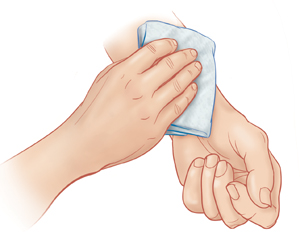You have a hemodialysis access in your arm, either an arteriovenous (AV) fistula or an artery to vein graft. An AV fistula is made by joining an artery and vein in your arm. An AV graft is a piece of soft tube that joins an artery and vein in your arm. It has been bleeding. Blood needs to flow freely through the fistula or graft. As part of your treatment, you are also taking medicine that thins your blood. This makes you bleed more easily. It's important to stop your fistula or graft from bleeding as soon as possible. You can quickly bleed to death from a rapidly bleeding hemodialysis access.
Home care
If your fistula or graft site is bleeding quickly, put pressure right on the spot that is bleeding with a gauze or cloth right away. Push hard until it stops. Then, get medical help right away.
If it's just oozing a small amount of blood, follow these directions:
-
Wash your hands. Dry them on a clean towel.
-
Put a small piece of sterile gauze on the area that's bleeding.
-
Press gently with your fingertips only on the area that is bleeding. Hold your fingers there for 30 minutes. Don't press on the whole forearm. Don't wrap anything around the wrist or arm, including bandages.
-
After 30 minutes, take your fingers off the area that was bleeding.
-
Wash and dry your hands again.
-
If it's still bleeding, call your health care provider or go to a hospital.
General access site care
These guidelines will help you care for your access site:
-
Wash your hands often. Keep the access site clean.
-
Check the fistula or graft for the pulsing feeling (“thrill”) every morning and night.
-
Follow these don'ts:
-
Don't let anyone take your blood pressure on your hemodialysis access arm.
-
Don't let anyone take blood from or inject medicine into the arm.
-
Don't wear jewelry or tight sleeves over the access site.
-
Don't wiggle the fistula or graft, or pick at your skin near the access.
-
Don't carry anything over the arm or lift heavy objects with that arm.
-
Don't sleep on your arm with the access site.
-
Follow-up care
Follow up with your provider as advised.
Call 911
Call
-
You have pain, cold, or numbness in the hand that won't go away.
-
The hand turns a pale color and won't go back to pink.
-
You have any major bleeding, or minor bleeding from the access site that won't stop.
When to contact your doctor
Contact your provider right away if:
-
You have a fever of 100.4°F (38°C) or higher, or as directed by your provider.
-
There's a red, hot, or swollen area around the access site.
-
A light-colored fluid is coming from the area around the access site.
-
You feel pain or hardness around the access site.
-
You've lost the pulsing feeling (“thrill”) over the fistula or graft.
-
You have new symptoms that concern you.


